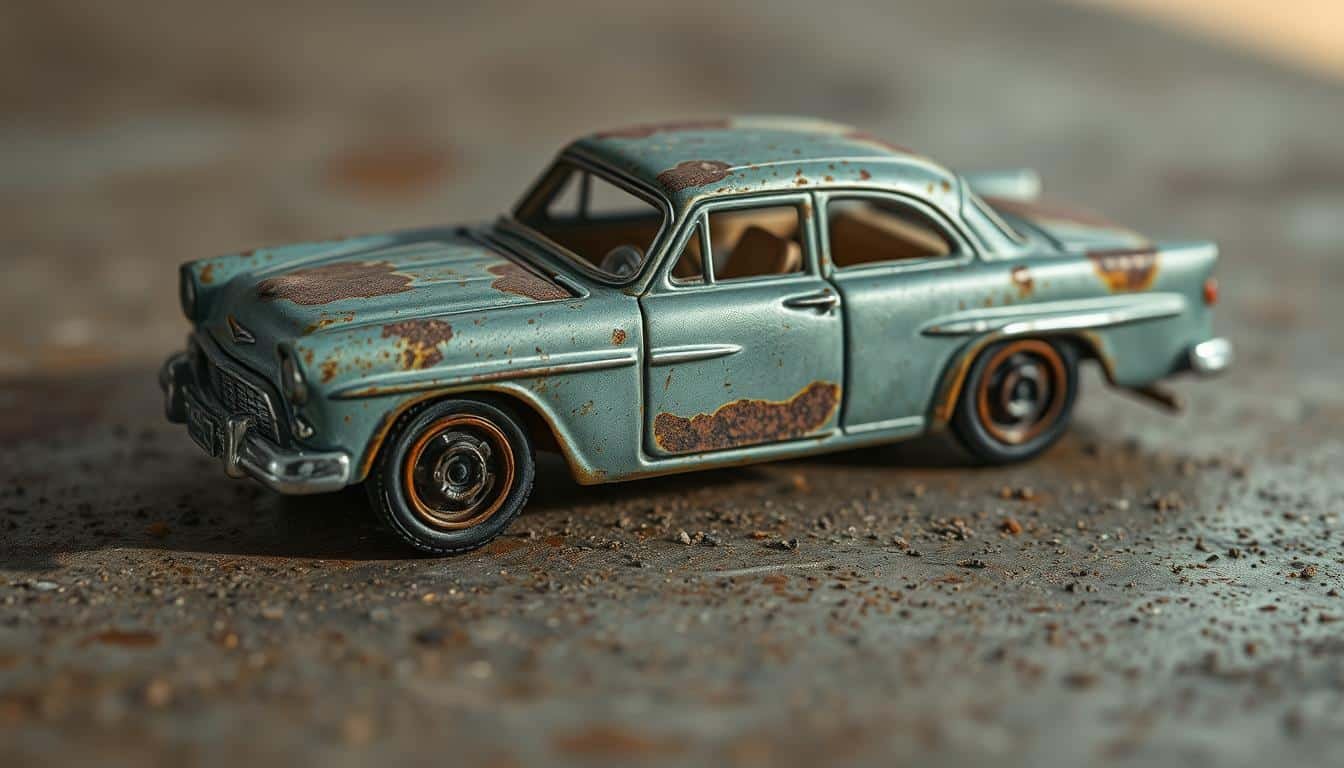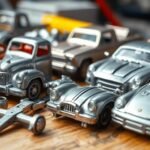Only 4% of collectors know zinc doesn’t rust but can corrode. This fact is crucial for diecast metal care. You might wonder about rust and how to protect your prized models.
Diecast models, made from Zamak alloy, don’t rust traditionally. However, they can still corrode. The alloy composition affects a model’s oxidation risk.
The main body resists rust well. But steel parts, like landing gear hubs, could be at risk. Understanding corrosion is key to preserving your collection.
Proper cleaning techniques are essential. 7% of collectors use distilled water to clean models. This reduces water-spotting and zinc corrosion risks.
Diecast metal oxidation differs from rust but is equally concerning. Protective coatings and paint shield against environmental factors. 6% of collectors praise RealMetal models’ clear coat for rust prevention.
Key Takeaways
- Diecast models don’t rust but can corrode
- Zamak alloy is the primary material for diecast models
- Steel components are more susceptible to rust
- Proper cleaning prevents corrosion and oxidation
- Protective coatings play a crucial role in preservation
- Understanding diecast alloy composition aids in care
Understanding Diecast Metal Composition and Corrosion Risk
Diecast models are prized collectibles made from special alloys. These metals are chosen for their durability and ability to capture fine details. The metal’s makeup is key to preserving diecast models and fighting corrosion.
What is Zamak Alloy and Its Properties
Zamak is the main alloy in diecast models. It mixes zinc, aluminum, magnesium, and copper. This blend is strong and resists corrosion, perfect for detailed model designs.
Zinc-based alloys like Zamak fight rust well. They also allow for various surface finishes, helping with diecast model care.
The Role of Protective Coatings and Paint
Treating diecast surfaces is crucial for long-term care. Most models have clear coats or finishes that guard against environmental harm. These layers block moisture and dirt from reaching the metal underneath.
Paint adds beauty and acts as another shield for the model.
Common Corrosion Types in Diecast Models
Zamak resists rust, but it’s not immune to all corrosion. Zinc pest and galvanic corrosion are common issues for collectors. Zinc pest happens when impurities cause the metal to expand and crumble.
Galvanic corrosion occurs when different metals touch in the presence of an electrolyte. Knowing these risks is vital for proper diecast model care.
| Alloy Type | Corrosion Resistance | Common Applications |
|---|---|---|
| Zamak | High | Diecast models, automotive parts |
| A380 Aluminum | Excellent | Structural components, cookware |
| Zinc-based | Very High | Small electronics, decorative items |
Does Diecast Metal Rust: Essential Facts for Collectors
Diecast metal collectors often worry about rust and corrosion risks. These models don’t rust like iron but face other corrosion threats. Understanding these risks is crucial for maintaining your collection.
Differences Between Rust and Other Types of Corrosion
Rust forms on iron-based metals, but diecast models use different alloys. They can experience tarnishing, pitting, and chemical reactions. These issues stem from various causes.
- Chemical reactions with packaging materials
- Improper cleaning and preparation
- Contamination from oils and organic compounds
Environmental Factors Affecting Diecast Models
Your collection’s environment plays a crucial role in diecast metal maintenance. Key factors include:
- Humidity levels
- Temperature fluctuations
- Exposure to direct sunlight
- Air quality and pollutants
High-Risk Areas for Corrosion on Models
Certain parts of diecast models are more prone to corrosion:
| Area | Risk Level | Prevention Tips |
|---|---|---|
| Exposed metal parts | High | Regular cleaning, proper storage |
| Joints and crevices | Medium | Careful dusting, avoid moisture accumulation |
| Painted surfaces | Low to Medium | Gentle handling, protection from UV light |
Knowing these factors helps protect your diecast collection from corrosion. This knowledge will help maintain its value for years to come.
Effective Cleaning and Maintenance Techniques

Proper diecast model care keeps your collection valuable and beautiful. Regular cleaning prevents dust buildup, which can harm paint over time. Let’s explore effective techniques for diecast surface treatment and metal maintenance.
Safe Cleaning Methods and Tools
Gentle methods are essential for diecast model care. Use soft brushes, microfiber cloths, or compressed air for routine dusting. For deeper cleaning, briefly submerge models in lukewarm water with mild soap.
Avoid harsh chemicals that could damage the finish. These can ruin your model’s appearance and value.
Proper Drying and Post-Cleaning Care
After cleaning, thorough drying is crucial in diecast metal maintenance. Pat models dry with a soft cloth, then air dry completely. This prevents water damage and potential corrosion.
For added protection, consider applying a specialized diecast surface treatment. Options like anodizing or powder coating can enhance your model’s durability.
Regular Maintenance Schedule Tips
Create a routine for your diecast model care:
- Weekly dusting to prevent grime buildup
- Monthly general cleaning with mild soap
- Quarterly deep cleaning for stubborn dirt
- Yearly inspection for any signs of corrosion or damage
Store your models in a clean, cool place away from direct sunlight. This helps maintain their pristine condition. With proper care, your collection will remain valuable and beautiful for years.
Conclusion
Preserving diecast metal models is vital for your collection. Zinc and aluminum alloys don’t rust like iron, but can still corrode. Zinc alloys form a protective layer when exposed to air, enhancing durability.
Proper care starts with understanding the materials used. ADC12 die-cast aluminum alloy is common in many items. It offers great properties but needs maintenance. Paint or powder coating protects against moisture and oxygen.
Regular cleaning and proper storage prevent rust on diecast models. Die-cast aluminum resists corrosion well in normal conditions. However, it may struggle in harsh environments.
By using proper care techniques, you can keep your collection beautiful. Being aware of risks helps preserve your diecast models’ value. With the right approach, your collection will last for years.
FAQ
Does diecast metal actually rust?
What is Zamak alloy and why is it used in diecast models?
What types of corrosion can affect diecast models?
How can I protect my diecast models from corrosion?
What are safe cleaning methods for diecast models?
How often should I clean my diecast models?
Can environmental factors affect diecast models?
What are the high-risk areas for corrosion on diecast models?
How important are protective coatings for diecast models?
What should I do if I notice signs of corrosion on my diecast model?
Source Links
- Do diecast models rust? – DA.C – https://www.diecastaircraftforum.com/1-200-scale-model-aircraft/95705-do-diecast-models-rust.html
- Corrosion Resistance | Die Casting Alloys | Die Casting Company – https://www.dynacast.com/en/knowledge-center/blog/corrosion-resistance-die-casting-alloys
- Understanding undercoat – https://www.planetdiecast.com/index.php?option=com_kunena&func=view&catid=83&id=28769&Itemid=0
- Corrosion Resistance: Die Casting Alloys – https://de.hebeiyogem.com/resources/corrosion-resistance-die-casting-alloy.html
- Understanding the Die Cast Metal Casting Process – https://etcnmachining.com/blog/die-casting/
- How to Clean & Preserve Diecast Scale Models – https://www.autoworldstore.com/blogs/tips-tricks/cleaning-diecast-models?srsltid=AfmBOorZcdbr5SlNIhi2wWbTdLE1FIo9elrsppWMLshzSU6avBvTVdEy
- How to: Clean a very dirty dust filled diecast – https://www.diecastxchange.com/threads/how-to-clean-a-very-dirty-dust-filled-diecast.65610/
- Tarnished & Staining (Polished Metal Models)…. Report by Dupont Polymers and Paints – https://www.diecastaircraftforum.com/1-200-scale-model-aircraft/179849-tarnished-staining-polished-metal-models-report-dupont-polymers-paints.html
- How to Clean & Preserve Diecast Scale Models – https://www.autoworldstore.com/blogs/tips-tricks/cleaning-diecast-models?srsltid=AfmBOopb0E5Sqe6_FSUdHHOJk8cFAuN95jIMOrUgbb7yqV5HPvR4YG8G
- 8 typical surface treatments for aluminum die-cast parts you have to know – https://www.linkedin.com/pulse/8-typical-surface-treatments-aluminum-die-cast-parts-you-clyde-verse-kbpvc
- Does Zinc Die Cast Rust? – Deco Products | Zinc Die Casting – https://decoprod.com/materials/does-zinc-die-cast-rust/
- Does Die Cast Aluminum Rust? How to Prevent Rusting?-Technology Articles-Shine-Choose Die Casting Manufacturing – https://www.shine-choose.com/html/en/in_the_news/271.html?srsltid=AfmBOoqV-KPjV_OaaY9z-qgDlSlKE0bDxHe3usoUjxgxFKbmA6lH361Y








Interesting read. But how would ceramic coatings be for diecast metal protection? Any ideas guys?
Interesting read! But, wouldnt using stainless steel diecasts mitigate the corrosion problem? Just a thought.
Interesting read! But, does anyone know if the same rust protection methods work for other alloys, not just Zamak?